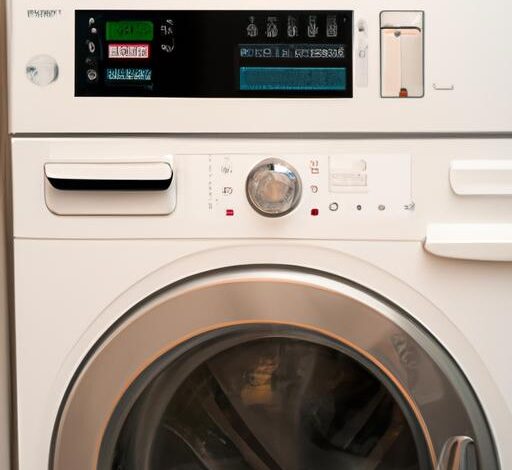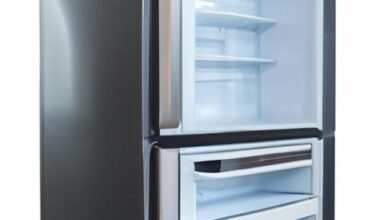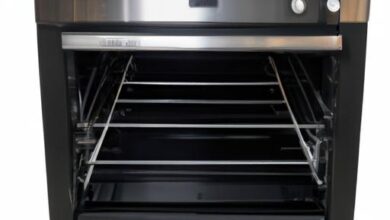Do Washing Machines Heat Their Own Water?

We all rely on washing machines to keep our clothes clean and fresh. But have you ever wondered how these incredible machines work? And more specifically, do washing machines heat their own water? In this article, we’ll dive into the fascinating world of washing machines and explore the role of water heating in their operation.
Introduction
Washing machines, also known as washers, are household appliances designed to automate the process of cleaning clothes. They have become an essential part of our lives, saving us time and energy. But one crucial aspect of washing machines often goes unnoticed – their ability to heat water.
Water heating in washing machines plays a vital role in achieving optimal cleaning results. Warm or hot water helps to dissolve detergent effectively, remove stains, and kill bacteria and allergens present in our garments. Without proper water heating, the cleaning efficiency of washing machines would be compromised.
Let’s take a moment to understand how washing machines work. These remarkable appliances consist of various components, including an agitator or impeller, a drum or tub, a motor, and a control panel. The washing process involves filling the drum with water, agitating the clothes to remove dirt, rinsing them, and finally spinning them to remove excess water.
Now that we have a basic understanding of washing machines, let’s delve deeper into the intriguing world of water heating. Join me as we explore the different types of washing machines and the mechanisms they employ to heat water.
Stay tuned for Section 2, where we’ll discuss how washing machines work in detail.
How do Washing Machines Work?
Exploring the Components
To understand how washing machines work, let’s take a closer look at their different components. A typical washing machine consists of an agitator or impeller, a drum or tub, a motor, and a control panel. The agitator or impeller is responsible for moving the clothes around, ensuring thorough cleaning. The drum or tub holds the clothes and water during the washing process. The motor powers the movement of the agitator or impeller and controls the spinning of the drum. Lastly, the control panel allows you to select various settings and programs for your laundry needs.
The Washing Process Unveiled
Now that we know the components, let’s uncover the washing process itself. It all begins by filling the drum with water. The water level can be adjusted based on the amount of laundry you have. Once the drum is filled, the detergent is added, and the machine is set to the desired settings. At this point, the machine’s motor activates the agitator or impeller, creating a back-and-forth motion that agitates the clothes. This motion helps to loosen dirt and stains, allowing the detergent to penetrate the fabric fibers.
During the washing process, water heating plays a crucial role. If you’ve chosen a warm or hot water setting, the washing machine will activate its water heating mechanism. The heated water aids in dissolving the detergent, effectively removing dirt and grime from your clothes. The temperature of the water can be adjusted based on the fabric type and the level of soiling.
After the agitating phase, the machine enters the rinsing stage. Fresh water is introduced into the drum to remove any remaining detergent and residue from the clothes. Finally, the machine spins the clothes at high speed to remove excess water, making them ready for drying.
The Role of Water Heating
Water heating is an essential component of the washing process. It helps to enhance the cleaning power of detergents by increasing their solubility and effectiveness. Warm or hot water is particularly useful for tackling tough stains, bacteria, and allergens, ensuring your clothes come out fresh and hygienic.
In Section 3, we’ll explore the different types of washing machines available in the market today.
Types of Washing Machines
When it comes to washing machines, there are various types available in the market, each offering unique features and advantages. Understanding the different types can help you make an informed decision based on your specific needs. Let’s explore the most common types of washing machines:
1. Top-Loading Machines
Top-loading machines, as the name suggests, have an opening on the top where you load your clothes. These machines are known for their convenience, as you can easily add or remove garments during the wash cycle. They also tend to be more affordable compared to front-loading machines. However, when it comes to water heating, top-loading machines typically use more water and energy, as they require a larger volume of water to fill the drum adequately.
2. Front-Loading Machines
Front-loading machines, on the other hand, have a door on the front that opens horizontally. These machines are known for their superior cleaning performance and energy efficiency. Front-loading machines use less water and energy compared to top-loading machines, making them more environmentally friendly and cost-effective in the long run. Additionally, they often have more advanced water heating mechanisms, allowing for better control over temperature settings.
3. Impact of Machine Type on Water Heating
The type of washing machine you choose can have a significant impact on water heating. Front-loading machines generally have more efficient heating mechanisms, such as internal water heaters, which allow precise temperature control. This ensures that the water is heated to the optimal temperature for effective cleaning. On the other hand, top-loading machines rely more on external water heaters, which may result in less accurate temperature control and potentially higher energy consumption.
When considering the impact of machine type on water heating, it’s important to note that both top-loading and front-loading machines can effectively heat their own water. However, the efficiency and control may vary between the two types.
In Section 4, we’ll explore the different water heating mechanisms used in washing machines.
Water heating mechanisms in washing machines
When it comes to heating water, washing machines employ various mechanisms to ensure optimal cleaning performance. Let’s take a closer look at these heating methods and understand their differences.
Overview of the heating mechanisms used in washing machines
Washing machines primarily use two types of water heating mechanisms: built-in and external systems.
Built-in water heating systems
Some washing machines come equipped with built-in water heating systems. These machines have a heating element, typically located at the bottom of the tub, which heats the water to the desired temperature. The heating element is controlled by the washing machine’s internal thermostat, ensuring that the water reaches the proper temperature for effective cleaning.
External water heating systems
Other washing machines rely on external water heating systems. In these machines, the water is supplied at the desired temperature from an external source, such as a water heater. These machines do not have a built-in heating element, but they can still control the temperature during the wash cycle by mixing hot and cold water.
Explanation of the differences between built-in and external water heating systems
Built-in water heating systems offer the advantage of providing consistent and precise control over the water temperature. They can heat the water to higher temperatures, which is particularly useful for removing tough stains and sanitizing clothes effectively. However, these machines tend to be more expensive and consume more energy compared to machines without built-in heating elements.
On the other hand, washing machines with external water heating systems rely on the temperature of the water supplied to them. This means that the maximum temperature achievable is limited by the output of the external water heater. While these machines may be more energy-efficient and affordable, they may not always reach the desired high temperatures for optimal cleaning.
Discussion on the advantages and disadvantages of each mechanism
The choice between a washing machine with a built-in or external water heating system depends on various factors. Built-in systems provide better control over water temperature, ensuring efficient cleaning. However, they come at a higher cost and may consume more energy. External water heating systems, although more energy-efficient, may have limitations when it comes to achieving higher temperatures.
Consider your specific needs, budget, and energy requirements when selecting a washing machine. Assess the importance of water temperature control and the trade-offs between performance and cost. By understanding the differences between these water heating mechanisms, you can make an informed decision that suits your washing needs.
Stay tuned for Section 5, where we’ll explore the impact of water heating on energy efficiency.
Energy Efficiency and Water Heating
Energy efficiency is a crucial factor to consider when choosing a washing machine. Not only does it help reduce energy consumption and utility bills, but it also has a significant impact on water heating. Let’s explore the importance of energy efficiency in washing machines and how it relates to water heating.
Importance of Energy Efficiency in Washing Machines
Energy-efficient washing machines are designed to minimize energy consumption while providing excellent cleaning performance. These machines utilize advanced technologies and innovative features to optimize water heating and overall efficiency. By choosing an energy-efficient washer, you not only conserve resources but also contribute to a greener and more sustainable environment.
Impact of Water Heating on Energy Consumption
Water heating accounts for a significant portion of a washing machine’s energy usage. In standard washing machines, the heating mechanism works by drawing water from your home’s hot water supply, thus relying on your water heater to heat the water. This process can consume a substantial amount of energy, particularly if your water heater is inefficient or set at a high temperature.
Energy-efficient washing machines, on the other hand, incorporate built-in water heating systems. These machines heat the water internally, allowing for precise temperature control and reducing the reliance on external water heaters. By heating the water directly within the washing machine, energy-efficient models can optimize energy consumption and minimize heat loss, resulting in significant energy savings over time.
Comparison of Energy-Efficient and Standard Machines
When comparing energy-efficient washing machines to standard models, it’s clear that the former offer several advantages. Energy-efficient machines are designed to meet strict energy efficiency guidelines and often carry certifications such as ENERGY STAR. These machines use less water and require shorter wash cycles, contributing to additional energy savings.
In contrast, standard machines may consume more energy due to their reliance on external water heaters and longer wash cycles. While they may be more affordable upfront, the higher energy consumption can lead to increased utility costs in the long run.
Stay tuned for Section 6, where we’ll conclude our exploration of washing machines and their water heating capabilities.
Conclusion
In conclusion, the question of whether washing machines heat their own water has been answered. Yes, washing machines do have the capability to heat water, and it plays a crucial role in achieving optimal cleaning results. The ability to use warm or hot water helps dissolve detergent effectively, remove stains, and eliminate bacteria and allergens from our clothes.
Throughout this article, we have explored the various components and mechanisms involved in water heating within washing machines. We have discussed the different types of machines available on the market, such as top-loading and front-loading machines, and how they impact the water heating process. Additionally, we have highlighted the importance of energy efficiency in washing machines and how it relates to water heating.
When choosing a washing machine, it is essential to consider its water heating capabilities. Machines with built-in water heating systems offer convenience and efficiency, ensuring that your clothes are thoroughly cleaned. By selecting an energy-efficient machine, you not only save on utility bills but also contribute to a greener environment.
So, the next time you load your laundry into the machine, take a moment to appreciate the technology that goes into heating the water for your clothes. Washing machines have come a long way, providing us with time-saving and effective cleaning solutions. With their ability to heat water, they have revolutionized the way we clean and care for our garments.
Remember, when it comes to washing machines, they not only clean our clothes but also have the power to make our lives easier. So, keep enjoying the convenience and efficiency of washing machines as they continue to evolve and improve in their water heating capabilities.
Thank you for joining me on this journey into the world of washing machines and water heating. Stay tuned for more insightful articles on household appliances and technology.
Conclusion: So above is the Do Washing Machines Heat Their Own Water? article. Hopefully with this article you can help you in life, always follow and read our good articles on the website: pet.top5dalat.com





